Tools
Most
kitchen table gunsmiths
damage good firearms beyond repair often because they don't
have the right tools. Here is a basic list of tools I
use to work on my own guns. This list is by no means
complete, and I didn't purchase them all at once. I
purchased them as I needed them for a particular
project. Let's face it, tools can be expensive, but
they're a lot cheaper than paying someone else to do the
work. I pay for a tool once, then I have it for future
projects. Polishing
Stones Polishing
Stones
I use polishing stones of different shapes and sizes
depending on the part I'm working on. I really can't
have enough of these very important tools. You can get
them from Brownells,
Midway USA, and a company called
Boride
Abrasives as shown in the photo.
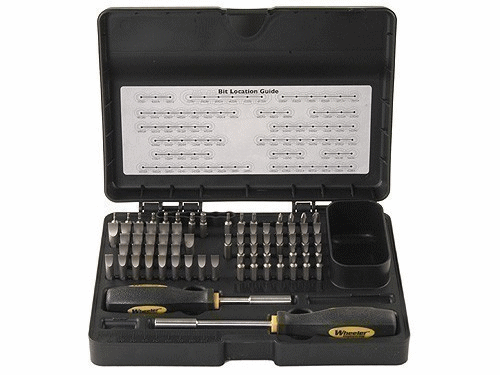
Hollow-Ground Screwdrivers
- Nothing will ruin screws quicker than taper-ground, hardware
store screwdrivers. These blades have a tendency to jump
out of the screw slot and mar the heads. Hollow-ground
screwdrivers are ground with parallel sides so they fit the
screw head properly. Used correctly they do not slip out
of the screw slot. Here is a nice set available from
Midway USA.
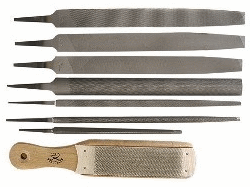 Files
- Files are the second most important tools I own for working
on firearms. I can purchase them at any hardware store
or home improvement center. I've also needed some specialty
files like 60 and 65 degree sight dovetail files or others as
the job requires. I always make sure I have some chalk
and a wire brush. I rub chalk into the file, which keeps
the teeth from getting full with metal chips. I use the
wire brush to clean the file, then re-chalk. Most files
are designed to be used in one direction only. I have
broken the teeth off of files by moving them back and forth. Files
- Files are the second most important tools I own for working
on firearms. I can purchase them at any hardware store
or home improvement center. I've also needed some specialty
files like 60 and 65 degree sight dovetail files or others as
the job requires. I always make sure I have some chalk
and a wire brush. I rub chalk into the file, which keeps
the teeth from getting full with metal chips. I use the
wire brush to clean the file, then re-chalk. Most files
are designed to be used in one direction only. I have
broken the teeth off of files by moving them back and forth.
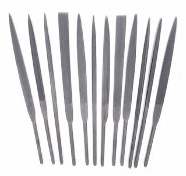
Jeweler's Files -
Sometimes called needle files, these are great for doing fine
work in small places where I don't need to remove a lot of
material. I purchased mine at my local home improvement
store. I have also found them in electrical supply
stores and hobby stores.
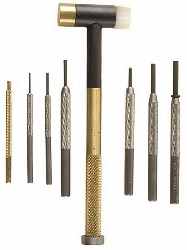 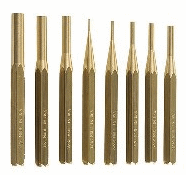
Punches
- I have a number of different punch sets; steel, brass, and
roll-pin. I use steel for regular pins, and brass for
when I don't want to mar the object such as when I'm
installing sights. A roll-pin punch has a raised dimple
in the middle of the face of the punch. This dimple fits
into the hole in the center of the roll-pin, which keeps it
from slipping off. Lyman sells a punch set that comes
with a mallet. The mallet has three types of heads;
steel, brass, and nylon.
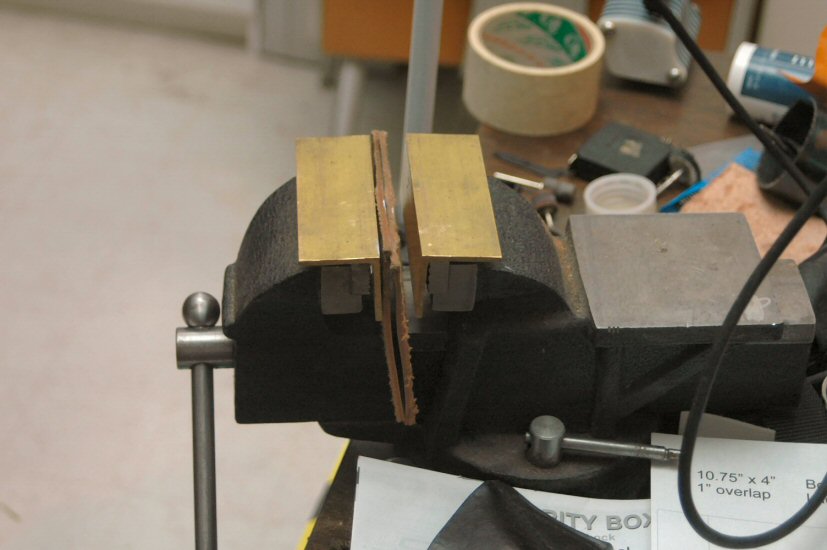 Vise
- I discovered early on that I needed a good 4-inch vise to
hold my work. Here you can see my vise with bronze vise
jaws available from Brownells. I have also padded my
jaws with leather to protect the finish of any firearm on
which I'm working. Before I had a permanent place to
work I mounted the vise to a block of wood and used C-clamps
to mount it to my kitchen table. Vise
- I discovered early on that I needed a good 4-inch vise to
hold my work. Here you can see my vise with bronze vise
jaws available from Brownells. I have also padded my
jaws with leather to protect the finish of any firearm on
which I'm working. Before I had a permanent place to
work I mounted the vise to a block of wood and used C-clamps
to mount it to my kitchen table.
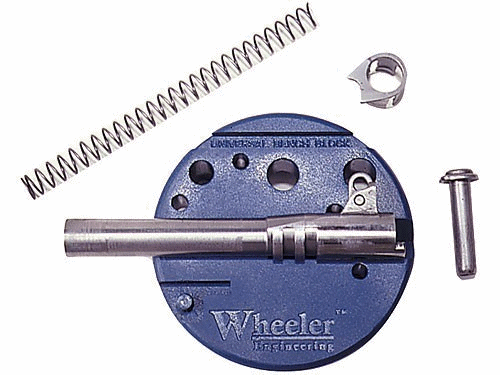
Bench Block - A bench block is a soft disk made of wood or
nylon used for removing pins. It has holes and grooves
for holding parts, or I can drill my own holes if
necessary. The bench block at left is make by Wheeler
Engineering available from Midway USA.
 Dial
or Digital Calipers - When working on firearms there are
some procedures that require precise measurements. A
good dial or digital calipers is the correct tool to
have. I have also needed other measuring tools for
different projects, but as stated before, I purchased them
when I needed them. Dial and digital calipers are
available at hardware and home improvement stores, Midway USA
and Brownells. Dial
or Digital Calipers - When working on firearms there are
some procedures that require precise measurements. A
good dial or digital calipers is the correct tool to
have. I have also needed other measuring tools for
different projects, but as stated before, I purchased them
when I needed them. Dial and digital calipers are
available at hardware and home improvement stores, Midway USA
and Brownells.
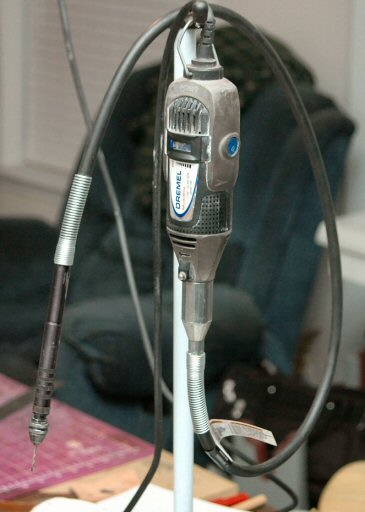 High
Speed Rotary Tool with Flexible Shaft - I have found a
high-speed rotary tool is invaluable for working on
firearms. However, many professional gunsmiths call the
rotary tool their best friend for bringing them
business. These tools rotate at speeds of 25,000 RPM or
more and can easily damage a firearm beyond the capabilities
of the kitchen table gunsmith. I always use my tool with
caution and respect. I also purchased a flexible shaft
for my rotary tool, which allows me to have more control. High
Speed Rotary Tool with Flexible Shaft - I have found a
high-speed rotary tool is invaluable for working on
firearms. However, many professional gunsmiths call the
rotary tool their best friend for bringing them
business. These tools rotate at speeds of 25,000 RPM or
more and can easily damage a firearm beyond the capabilities
of the kitchen table gunsmith. I always use my tool with
caution and respect. I also purchased a flexible shaft
for my rotary tool, which allows me to have more control.

Trigger Pull Gauge - A trigger pull gauge measures the
weight of trigger pull. This tool helps me to determine
how effective my trigger work is. I measure the pull
weight both before and after I perform action work. This
simple gauge shown on the right is available from Midway USA
and is very inexpensive.
 Headspace
Gauges - When I purchase a used pistol or rifle I usually
purchase headspace gauges for safety reasons. Headspace
gauges come in three sizes; Go, No-Go, and Field. If the
go gauge chambers properly the chamber is long enough.
If not, I know the chamber is too short and needs to be
reamed. If the no-go gauge won't chamber then the
chamber is ok. If the no-go gauge chambers, the chamber
is too long and unsafe, probably stretched, so I'll have to
shorten the chamber by removing metal off the rear of the
barrel. The use of the field gauge is debated by professional
gunsmiths. Some say if the bolt closes on a field gauge,
don't use the rifle. Some say use the rifle. I
don't use field gauges at all. If the chamber is between
the go and no-go gauges, for me the chamber is safe.
When using these gauges, especially on a semi-automatic
firearm, I remove all springs and extractors. I always
test with light finger pressure only. Using springs or
excessive pressure can damage the gauges. Headspace
Gauges - When I purchase a used pistol or rifle I usually
purchase headspace gauges for safety reasons. Headspace
gauges come in three sizes; Go, No-Go, and Field. If the
go gauge chambers properly the chamber is long enough.
If not, I know the chamber is too short and needs to be
reamed. If the no-go gauge won't chamber then the
chamber is ok. If the no-go gauge chambers, the chamber
is too long and unsafe, probably stretched, so I'll have to
shorten the chamber by removing metal off the rear of the
barrel. The use of the field gauge is debated by professional
gunsmiths. Some say if the bolt closes on a field gauge,
don't use the rifle. Some say use the rifle. I
don't use field gauges at all. If the chamber is between
the go and no-go gauges, for me the chamber is safe.
When using these gauges, especially on a semi-automatic
firearm, I remove all springs and extractors. I always
test with light finger pressure only. Using springs or
excessive pressure can damage the gauges.

Wet/Dry Sand Paper, Various Grits - For polishing small
parts I use black wet/dry sand paper in various grits. I
normally keep 320/400 and 600 grit handy at all
times.
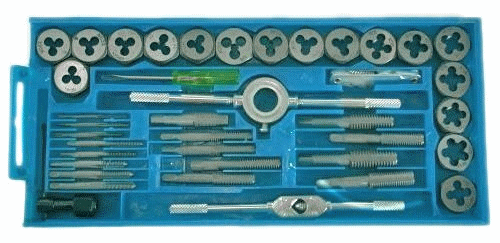 Tap
and Die Set - A good quality tap and die set is another
tool that is good to have. Taps allow me to thread holes
to receive screws, and dies allow me to thread rod to make my
own screws. I also purchased firearm-specific taps from
Brownells which have finer threads for use with gunsmith
screws. Tap
and Die Set - A good quality tap and die set is another
tool that is good to have. Taps allow me to thread holes
to receive screws, and dies allow me to thread rod to make my
own screws. I also purchased firearm-specific taps from
Brownells which have finer threads for use with gunsmith
screws.
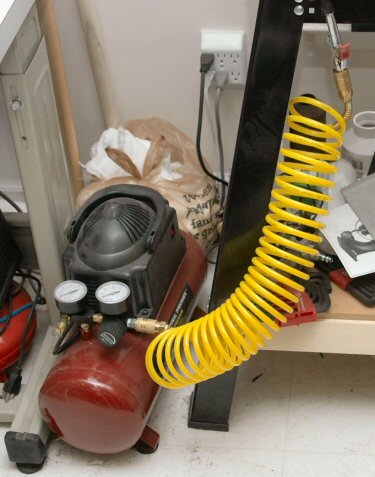
Air Compressor - I use a small air compressor to clean
off parts after I have performed filing or grinding. The
forced air helps to get grit and particles out of hard to
reach places. I also use my air compressor with an air
brush to coat firearms with paint-on finishes.
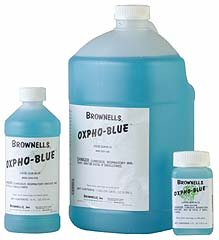 
Cold Blue - I use cold bluing solution to protect small
areas of parts I have worked on, or to completely refinish
parts. I use Oxpho-Blue from Brownells for coating
exposed metal on parts on which I have worked, and I use Van's
Instant Gun Blue to totally refinish parts.
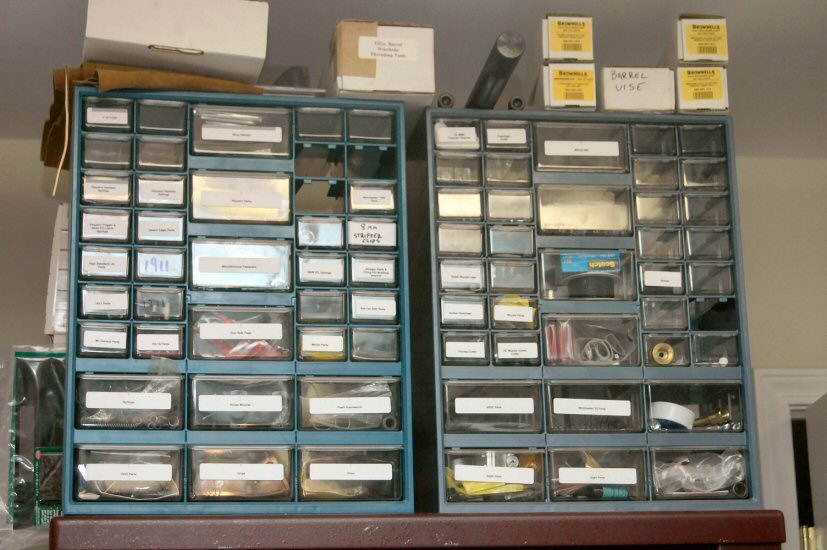
Parts Bins/Organizers - I use plastic multi-drawer
organizers for parts and tools. Being somewhat of a
pack-rat, I keep everything, even if it is damaged.
You'd be surprised how many times I've used a leftover part or
spring to fix something else.
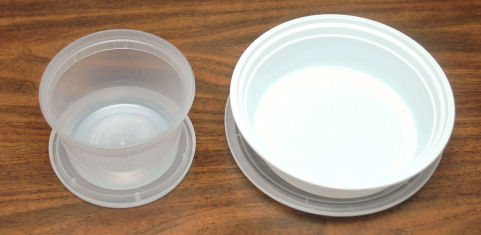
My
wife and I love Chinese food; in fact we eat at our local
Chinese restaurant at least once a week. When we order
take out my restaurant has started to use plastic tubs, which
work great for holding chemicals and parts. And because
they come with a lid, I don't have to worry about spilling the
chemicals or losing the parts. Library
- My gunsmithing books are just as important as my other
tools. I refer to them regularly for disassembly
instructions. They also provide me with tips for
performing general gunsmith work, and how to work on specific
firearms. My most valuable books in my library are The
Official NRA Guide to Firearms Assembly Two Volume Set. These
books provide exploded diagrams and step-by-step disassembly
instructions for many firearms. Advanced
Tools - I have a number of what I call advanced tools for
working on firearms. The tool that took me from
performing amateur work to semi-professional work was my
mill/drill. I purchased mine from Harbor Freight Tools,
but if I had to do it over, I would purchase the Grizzly G8689
Mini Milling Machine. This tool has a tilting head which
makes angle cuts very easy.
|